
The Liverpool and Manchester Railway (L&MR) was the first inter-city railway in the world. It opened on 15 September 1830 between the Lancashire towns of Liverpool and Manchester in England. It was also the first railway to rely exclusively on locomotives driven by steam power, with no horse-drawn traffic permitted at any time; the first to be entirely double track throughout its length; the first to have a true signalling system; the first to be fully timetabled; and the first to carry mail.
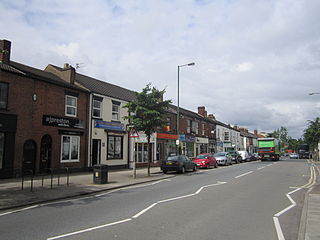
Newton-le-Willows is a market town in the Metropolitan Borough of St Helens, Merseyside, England. The population at the 2021 census was 24,642. Newton-le-Willows is on the eastern edge of St Helens, south of Wigan and north of Warrington.
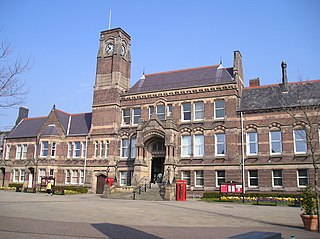
The Metropolitan Borough of St Helens is a local government district with borough status in Merseyside, North West England. The borough is named after its largest settlement, St Helens, but also includes neighbouring towns and villages such as Earlestown, Rainhill, Eccleston, Clock Face, Haydock, Billinge, Garswood, Rainford and Newton-le-Willows.

The Sankey Canal in North West England, initially known as the Sankey Brook Navigation and later the St Helens Canal, is a former industrial canal, which when opened in 1757 was England's first of the Industrial revolution, and the first modern canal.

Earlestown railway station is a railway station in Earlestown, Merseyside, England, and one of the few "triangular" stations in Britain.

Haydock is a village within the Metropolitan Borough of St Helens, in Merseyside, England. At the 2011 Census, it had a population of 11,416 Haydock's historic area covers the Haydock electoral ward and a section of the Blackbrook ward.

St Helens is a town in Merseyside, England, with a population of 102,629. It is the administrative centre of the Metropolitan Borough of St Helens, which had a population of 183,200 at the 2021 Census.
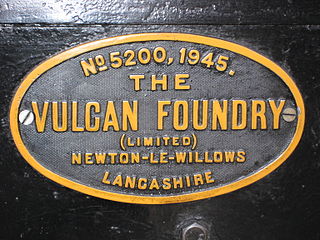
The Vulcan Foundry Limited was an English locomotive builder sited at Newton-le-Willows, Lancashire.

The St Helens and Runcorn Gap Railway was an early railway line owned by a company of the same name in Lancashire, England, which opened in 1833. It was later known as St Helens Railway. It ran originally from the town of St Helens to the area which would later develop into the town of Widnes. Branches were opened to Garston, Warrington and Rainford. The company was taken over by the London and North Western Railway in 1864. The line from St Helens to Widnes and the branch to Rainford are now closed, the latter terminating at the Pilkington Glass' Cowley Hill works siding near Gerard's Bridge, but part of the lines to Garston and to Warrington are still in operation.
The Warrington and Newton Railway was a short early railway linking Warrington to the Liverpool and Manchester Railway at Newton, and to pits at Haydock, nearby. It opened in 1831.
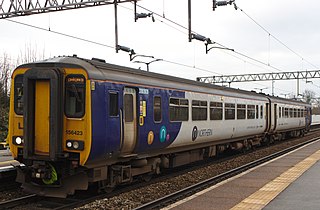
There once were four direct railway routes between Liverpool and Manchester in the North West of England; only two remain, the two centre routes of the four. The most northerly and the most southerly of the four routes are no longer direct lines. Of the remaining two direct routes, the northern route of the two is fully electric, while the now southern route is a diesel-only line. The most northerly of the four has been split into two routes: the western section operated by Merseyrail electric trains and the eastern section by diesel trains, requiring passengers to change trains between the two cities. The fourth route, the most southerly of the four, has been largely abandoned east of Warrington; the remaining section caters mainly for freight trains.

Newton-le-Willows railway station is a railway station in the town of Newton-le-Willows, in the Metropolitan Borough of St Helens, and at the edge of the Merseytravel region. The station is branded Merseyrail. The station is situated on the northern route of the Liverpool to Manchester Line, the former Liverpool and Manchester Railway which opened in 1830. It is a busy feeder station for nearby towns which no longer have railway stations, such as Golborne, Billinge and Haydock. There is also a complimentary bus shuttle service to Haydock Park Racecourse on certain racedays.
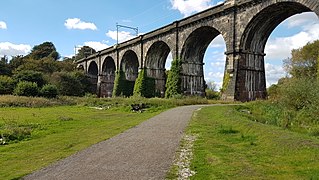
The Sankey Viaduct is a railway viaduct in North West England. It is a designated Grade I listed building and has been described as being "the earliest major railway viaduct in the world".
There are various modes of transport available in Warrington.
Collins Green railway station was a railway station in Burtonwood, Warrington, England. It was in operation between 1830 and 1951.

St Helens Central (GCR) railway station served the town of St Helens, England with passenger traffic between 1900 and 1952 and goods traffic until 1965. It was the terminus of a branch line from Lowton St Mary's.
St Helens is a town in the Metropolitan Borough of St Helens, Merseyside, England. The unparished area contains 67 buildings that are recorded in the National Heritage List for England as designated listed buildings. Of these, one is listed at Grade I, the highest grade, five are listed at Grade II*, the middle of the three grades, and the others are at Grade II, the lowest grade. The main town in the district is St Helens, the others being Newton-le-Willows and Earlestown. Until the Industrial Revolution, the area was largely rural. Coal mining began in the 16th century, but modern industrial development began with the construction of the Sankey Canal in the late 18th century, linking St Helens with the River Mersey. The early 19th century saw new industries, including copper smelting, production of alkali, and the manufacture of glass. Of these, the major industry was glass making, the main business being that of Pilkingtons. The first major railway line in the world, the Liverpool and Manchester Railway was built through the district, opening in 1830.
Sankey Bridges railway station was in southwestern Warrington, England. It was located immediately west of a swing bridge over the Sankey Canal. The station site is to the south of Old Liverpool Road, Warrington.

Lowton railway station served the village named Town of Lowton to the east of Newton-le-Willows and south of Golborne.

Earlestown Town Hall is a municipal building in Market Street in Earlestown, Merseyside, England. The building, which was the headquarters of Newton-le-Willows Urban District Council, is a Grade II listed building.


















